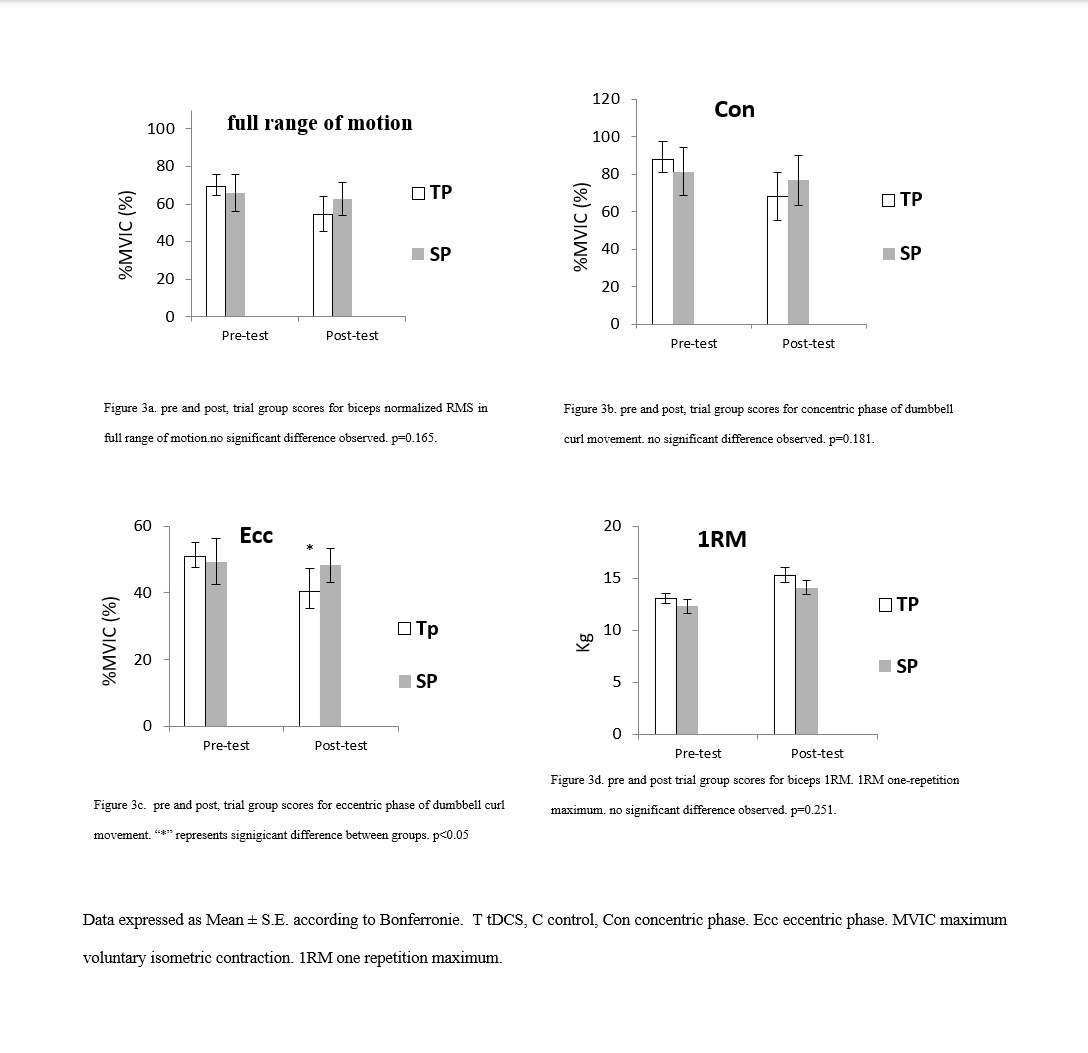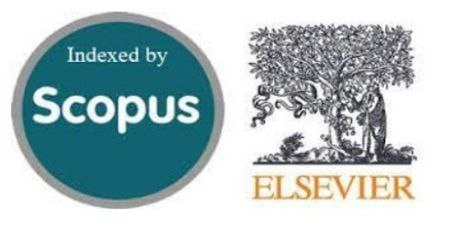Transcranial Direct Current Stimulation Combined with Practical Blood Flow Restriction Training Enhances Efficiency in the Eccentric Phase of the Dumbbell Curl Movement, not the Concentric
Keywords:
tDCS, pBFR , EmgAbstract
Objective. Transcranial direct current stimulation is a risk-free technique that stimulates the brain using a low-intensity current. Effectively increasing muscle thickness and maximal strength is possible with practical blood flow restriction training. The objective of this research endeavor was to examine the synergistic impacts of practical blood flow restriction training and transcranial direct current stimulation on the electrical activity and dynamic strength of the biceps brachii throughout concentric and eccentric phases of motion.
Methods. A total of twenty healthy participants were designated at random to either the sham-pBFR group (n=9) or the tDCS-pBFR group (n=11). The sham-pBFR group was administered sham-tDCS and pBFR, whereas the tDCS-pBFR group was administered pBFR and anodal tDCS over the M1 with an intensity of 1.5 (mA). The participants executed dumbbell curls for the biceps at 80% of their 1RM. Following initial assessments, a covariance analysis was performed.
Results. The findings indicate that the combination of tDCS and pBFR training did not result in a synergistic effect on dynamic strength (p=0.251), concentric phase electrical activity (p=0.181), or the full range of biceps brachii dumbbell curl motions (p=0.165). However, a synergistic effect was observed during the eccentric phase of motion (p=0.049).
Conclusions. Our research shows that tDCS improves the efficiency and neuromuscular economy of muscle fiber recruitment during the eccentric phase of dumbbell curl movements when combined with pBFR training.
Downloads
References
1. Nitsche MA, Paulus W. Excitability changes induced in the human motor cortex by weak transcranial direct current stimulation. The Journal of physiology. 2000;527(Pt 3):633. [PMID: 10990547 ] [PMCID: PMC2270099] [DOI]
2. Manini TM, Clark BC. Blood flow restricted exercise and skeletal muscle health. Exercise and sport sciences reviews. 2009;37(2):78-85. [PMID: 19305199] [DOI]
3. Moritani T, DeVries HA. Neural factors versus hypertrophy in the time course of muscle strength gain. American journal of physical medicine & rehabilitation. 1979;58(3):115-30.
4. Aagaard P, Bojsen-Møller J, Lundbye-Jensen J. Assessment of neuroplasticity with strength training. Exercise and Sport Sciences Reviews. 2020;48(4):151-62. [PMID: 32658038] [DOI]
5. Folland JP, Williams AG. Morphological and neurological contributions to increased strength. Sports medicine. 2007;37:145-68. [PMID: 17241104] [DOI]
6. Cook SB, Murphy BG, Labarbera KE. Neuromuscular function after a bout of low-load blood flow-restricted exercise. Medicine and science in sports and exercise. 2013;45(1):67-74. [PMID: 22895371] [DOI]
7. Hendy AM, Kidgell DJ. Anodal-tDCS applied during unilateral strength training increases strength and corticospinal excitability in the untrained homologous muscle. Experimental brain research. 2014;232:3243-52. [PMID: 24942703] [DOI]
8. Hikosaka M, Aramaki Y. Effects of bilateral transcranial direct current stimulation on simultaneous bimanual handgrip strength. Frontiers in Human Neuroscience. 2021;15:674851. [PMID: 34149384] [PMCID: PMC8206279] [DOI]
9. McCafferty WB, Horvath SM. Specificity of exercise and specificity of training: a subcellular review. Research Quarterly American Alliance for Health, Physical Education and Recreation. 1977;48(2):358-71. [DOI]
10. Nitsche MA, Paulus W. Sustained excitability elevations induced by transcranial DC motor cortex stimulation in humans. Neurology. 2001;57(10):1899-901. [PMID: 11723286] [DOI]
11. Enoka RM. Eccentric contractions require unique activation strategies by the nervous system. Journal of applied physiology. 1996;81(6):2339-46. [PMID: 9018476] [DOI]
12. Fang Y, Siemionow V, Sahgal V, Xiong F, Yue GH. Greater movement-related cortical potential during human eccentric versus concentric muscle contractions. Journal of Neurophysiology. 2001;86(4):1764-72. [PMID: 11600637] [DOI]
13. Nardone A, Romano C, Schieppati M. Selective recruitment of high‐threshold human motor units during voluntary isotonic lengthening of active muscles. The Journal of physiology. 1989;409(1):451-71. [PMID: 10990547 ] [PMCID: PMC2270099] [DOI]
14. Hortobagyi T, Hill JP, Houmard JA, Fraser DD, Lambert NJ, Israel RG. Adaptive responses to muscle lengthening and shortening in humans. Journal of applied physiology. 1996;80(3):765-72. [PMID: 8964735] [DOI]
15. Tesch P, Dudley G, Duvoisin M, Hather B, Harris R. Force and EMG signal patterns during repeated bouts of concentric or eccentric muscle actions. Acta Physiologica Scandinavica. 1990;138(3):263-71. [PMID: 2327260] [DOI]
16. Wang B, Xiao S, Yu C, Zhou J, Fu W. Effects of transcranial direct current stimulation combined with physical training on the excitability of the motor cortex, physical performance, and motor learning: a systematic review. Frontiers in Neuroscience. 2021;15:648354. [PMID: 33897361] [PMCID: PMC8062775] [DOI]
17. Jung J, Salazar Fajardo JC, Kim S, Kim B, Oh S, Yoon B. Effect of tDCS Combined With Physical Training on Physical Performance in a Healthy Population. Research Quarterly for Exercise and Sport. 2023:1-8. [PMID: 37036388] [DOI]
18. Nitsche MA, Schauenburg A, Lang N, Liebetanz D, Exner C, Paulus W, et al. Facilitation of implicit motor learning by weak transcranial direct current stimulation of the primary motor cortex in the human. Journal of cognitive neuroscience. 2003;15(4):619-26. [PMID: 12803972] [DOI]
19. Clark BC, Manini T, Hoffman R, Williams P, Guiler M, Knutson M, et al. Relative safety of 4 weeks of blood flow‐restricted resistance exercise in young, healthy adults. Scandinavian journal of medicine & science in sports. 2011;21(5):653-62. [PMID: 21917016 ] [PMCID: PMC6152804] [DOI]
20. Wilson JM, Lowery RP, Joy JM, Loenneke JP, Naimo MA. Practical blood flow restriction training increases acute determinants of hypertrophy without increasing indices of muscle damage. The Journal of Strength & Conditioning Research. 2013;27(11):3068-75. [PMID: 23446173] [DOI]
21. Brzycki M. Strength testing—predicting a one-rep max from reps-to-fatigue. Journal of physical education, recreation & dance. 1993;64(1):88-90. [DOI]
22. Cadore EL, Pinto R, Lhullier F, Correa C, Alberton C, Pinto S, et al. Physiological effects of concurrent training in elderly men. International journal of sports medicine. 2010:689-97. [PMID: 20617484] [DOI]
23. Cadore EL, Pinto RS, Alberton CL, Pinto SS, Lhullier FLR, Tartaruga MP, et al. Neuromuscular economy, strength, and endurance in healthy elderly men. The Journal of Strength & Conditioning Research. 2011;25(4):997-1003. [PMID: 20881506] [DOI]
24. Bruce AS, Howard JS, Van Werkhoven H, McBride JM, Needle AR. The effects of transcranial direct current stimulation on chronic ankle instability. Med Sci Sports Exerc. 2020;52(2):335-44. [PMID: 31453883] [DOI]
25. Furuya S, Klaus M, Nitsche MA, Paulus W, Altenmüller E. Ceiling effects prevent further improvement of transcranial stimulation in skilled musicians. Journal of Neuroscience. 2014;34(41):13834-9. [PMID: 25297109] [PMCID: PMC6608385] [DOI]
26. Rosen DS, Erickson B, Kim YE, Mirman D, Hamilton RH, Kounios J. Anodal tDCS to right dorsolateral prefrontal cortex facilitates performance for novice jazz improvisers but hinders experts. Frontiers in Human Neuroscience. 2016;10:579. [PMID: 27899889 ] [PMCID: PMC5110534] [DOI]
27. Beaulieu L-D, Blanchette AK, Mercier C, Bernard-Larocque V, Milot M-H. Efficacy, safety, and tolerability of bilateral transcranial direct current stimulation combined to a resistance training program in chronic stroke survivors: A double-blind, randomized, placebo-controlled pilot study. Restorative neurology and neuroscience. 2019;37(4):333-46. [PMID: 31227673] [DOI]

Downloads
Additional Files
Published
Issue
Section
License
Copyright (c) 2025 Behzad Taheri (Author); Ziya Fallahmohammadi (Corresponding Author); Khadijeh Irandoust , Somayeh Namdar Tajari (Author)

This work is licensed under a Creative Commons Attribution-NonCommercial 4.0 International License.







